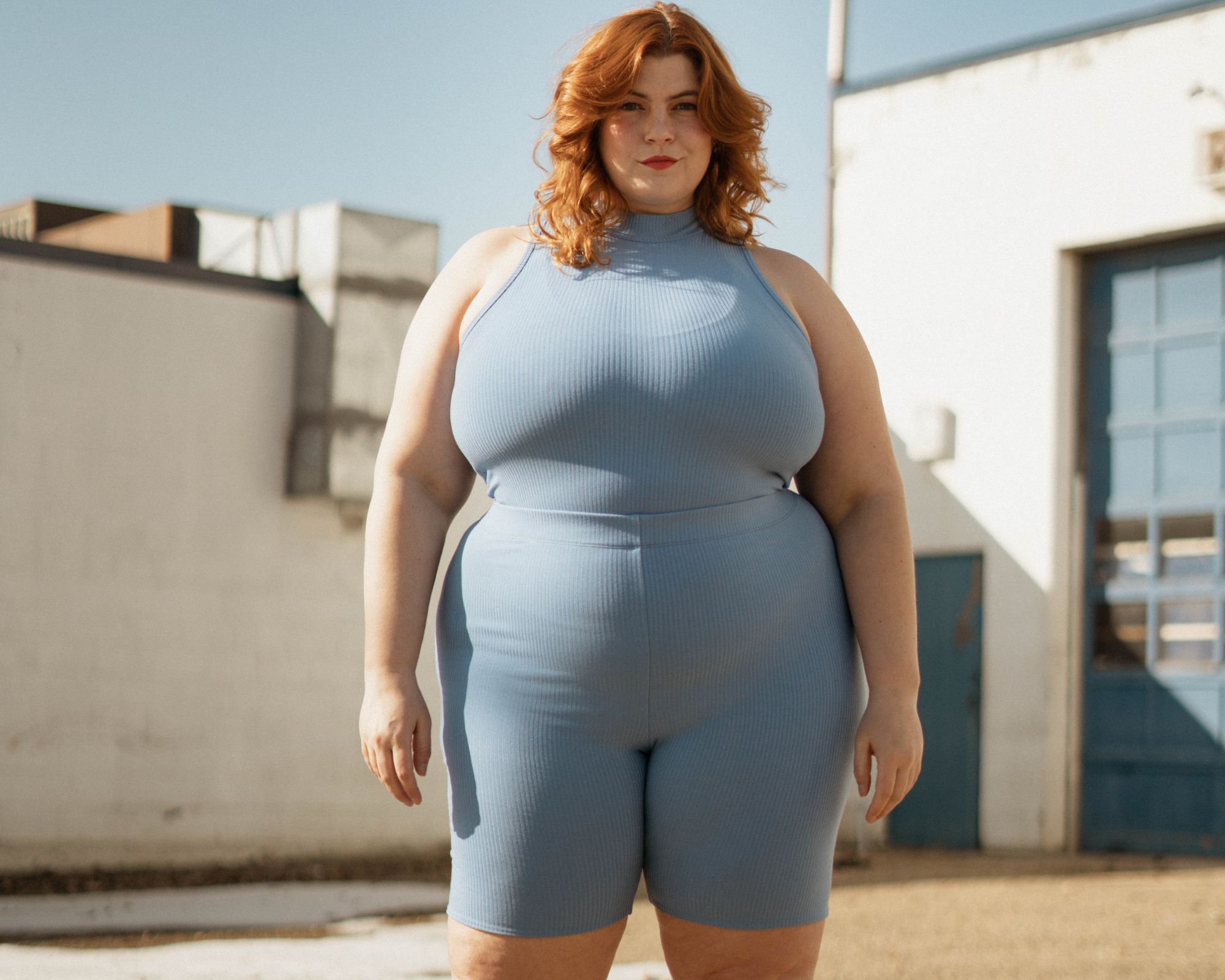Plus-sized fashion photographer and writer Marielle Elizabeth reports on the state of inclusive sizing in the ethical fashion space today. Key takeaways: anti-fat bias remains prevalent but some brands are getting it right.
Sized out of ethical fashion
I fell in love with the ethical fashion scene when I was eighteen by wandering into a local boutique dedicated to responsibly-made clothing. I was awestruck by the carefully curated selection of brands, each with a story about who made their clothes.
It was a sharp contrast from my summer job as a sales associate at a fast fashion retailer where new “seasons” launched every two weeks and I spent hours sorting the overstuffed 50% off discount racks.
There was only one problem: very few things in the tastefully appointed shop came in my size. As a 2XL, my body was sized out of most of the brands, my heart sank, and my decade long fight for size inclusion within ethical fashion began.
The problem feels comically obvious—we desperately need to lessen the harmful impacts of the fashion industry by moving away from fast fashion and the average American woman wears plus sizes. Why then is it still so difficult to find plus size responsibly-made clothes? How can I be a part of the change if no one is making my size?
View this post on Instagram
Structural barriers to carrying plus size ranges
“Plus sized people are going to buy and wear the clothes that fit them. There is huge business potential for ethical/sustainable fashion to cement itself further with plus sizes,” Lydia Okello—plus-size influencer, model, and writer based in Vancouver—tells me.
“Plus size fashion is one of the fastest growing categories year over year,” they say. “I don’t want to live on a planet with landfills continuing to overflow with fast fashion; we need more options.”
Despite a clear demand for size inclusivity growing across the fashion industry, brands are often quick to push back with a myriad of reasons why catering to the plus customer isn’t feasible for their business.
Financially, the investment to properly grade plus sizing beyond an 18 or 2XL—which requires building a new set of grading rules—is a process that takes time and money. For brands that manufacture collections outside of a made-to-order model, that investment increases as they need to pay for plus size garments (significantly increasing the number of SKUs they put into production) without knowing the uptake of those sizes as they build their customer base, as well as running the risk of grading errors rendering larger product runs unsellable.
Structurally, fashion and design programs have historically neglected teaching plus size grading and designing for the bigger body in curriculums, making it hard to find designers that have experience working with plus drafting. This can lead to longer design times and more trial and error as the grading rules are developed. If these steps are skipped, the grading in plus sizing would be inaccurate, resulting in returns and dissatisfied customers—neither of which are sustainable.
View this post on Instagram
Anti-fat bias in the industry and building brand loyalty
And, of course, there is the pervasive anti-fat bias that prevents brands from even considering if the plus-size customer is worth pursuing.
A common example I’ve encountered in ethical fashion spaces is the belief that fat people view their bodies as transitional and therefore won’t spend money on higher priced clothing, which ethically produced fashion tends to be. This is premised on the erroneous assumption that fat people are dissatisfied with their appearance. This is problematic for a host of reasons not least because it implies that fat bodies are forever thin bodies in progress.
Another is brands not wanting their garments associated with fat people and the idea that plus size customers “don’t fit” into their definition of aspirational.
Despite these barriers, I’m forever hopeful and inspired by brands that take on the challenge of size expansion. Sotela, a made-to-order brand which offers an extensive size range and further customisation, focused on expanding their size range above an XL just two years into their business.
“It will always be a good return on investment to make clothing for more people. Period,” says Hanna Baror-Padilla, founder of Sotela. “There are ways to expand sizing that are cost effective like using a preorder system to ensure you only make what you sell. The upfront costs of creating patterns and grading sizes will always be there, but it’s worth it when you can sell to the majority of people.”
Sotela ensures all garment prices are the same regardless of size, by averaging out material and time costs.
“Building trust with customers who have been slighted by the fashion industry is no easy feat. We’ve had to continuously work on our fit and designs to ensure it fits a plus size customer the same way,” explains Baror-Padilla. “It took about three collections before we got our fit down and finally saw an increase in our plus size orders. With every collection, our plus size orders have grown—35% of our total orders are plus size.”
That sense of brand loyalty between the plus community and brands that stick with it, is something that Okello reiterates from the customer side.
There’s nothing more frustrating than a brand who does a half hearted launch of a few extended size items for a single season, with no marketing to the plus community, and then drops it a season later.
Lydia Okello – plus-size influencer
And much of it comes down to ensuring the product brands are selling fits as expected, even if it takes a few seasons. “If the sizing is inconsistent, I think the plus customer is quick to leave a brand behind,” says Okello. “Mass produced brands often have more consistent plus sizing due to their resources—many plus customers learn what fast fashion always fits and have loyalty to those brands.”
In this area, brands don’t have a lot of excuses, as the solution seems obvious. “Fit test on fat people,” Okello tells me. “Listen to their feedback and show your clothing on fat bodies. It’s helpful to see the fit on plus sized models, since many plus options are also online only.
“There’s nothing more frustrating than a brand who does a half hearted launch of a few extended size items for a single season, with no marketing to the plus community, and then drops it a season later.”
So which brands are doing it right?
I am always buoyed by the memory of that first introduction to ethical fashion and the difference I feel shopping now, albeit mostly online. There are countless brands that have worked hard to expand their sizing—with more options up to a 3XL, and hopefully more brands going up to a 6XL in the near future—whose garments proudly hang in my closet.
ABLE is another brand making size expansion a priority, with the launch of their extended sizes in March 2022 (offering the majority of their collection up to a 3XL): “We knew that we could not empower ALL women, if we couldn’t make clothing that fit them. And the idea of leaving women out of being a part of our brand—our community—simply because we didn’t offer their size, didn’t align with our core values.”
My most recent purchases include a new adjustable bikini from Free Label (XS-5XL), cashmere ribbed joggers from Naadam (2XS-3XL), and a ruffle dress from Em & May (custom sizing available) made with deadstock fabric. I also lucked out and found perfectly fitting denim overalls from the early 2000s at a local vintage shop. I’m incredibly excited to see the growth of plus size vintage and second hand online clothing retailers, making finding sustainable second hand pieces (at a wider array of price points) easier regardless of where you live. Another second hand purchase I made recently was a WRAY dress for less than half the price it originally retailed for.
Okello echoes my sentiments, saying they too are feeling more inspired season after season when they dig into the growing offerings in the sustainable fashion space.
“I’m excited about bold, eye-catching clothing and details right now. Punchy colors, rich textures, and magpie type pieces,” they share. “I always come back to the effusive joy of WRAY NYC and I’m thinking about possibly getting back into hats thanks to Heirloom Hats—the fantasy and joy is real. I also love the vibe of Ganni. Essentially I’m looking for apparel that is joyful, comfortable, and exciting.”
It is imperative to the future of our planet that the plus size community feels wanted, welcomed, and needed within the ethical and sustainable fashion community—that both brands and the plus community hold space for one another as we work towards that goal, with a focus on progress over perfection and a desire to keep innovating and improving.
And in the moments when my optimism falters, I remind myself that if this is the progress we’ve been able to make in the last ten years, what incredible possibilities there are for the next ten, and I’m proud to be a part of that story.


















